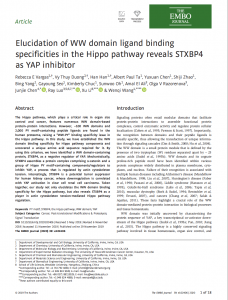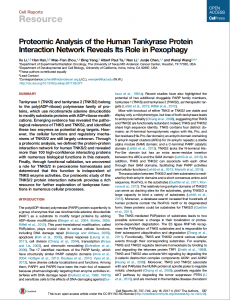The Wang lab
The goal of our research program is to dissect the signaling network underlying tissue homeostasis and organ size control as well as its dysregulation in tumorigenesis. The recognition in the past decades that the Hippo is a crucial signaling pathway in organ size control allows us to take the first step to achieve this long-term goal. We are taking advantage of multi-disciplinary approaches including biochemistry, cell biology, bioinformatics, proteomics and genetic mouse model, to dissect the upstream regulation and downstream cellular function of the Hippo pathway. Given its well-established tumor suppressive role in restricting proliferation, we hope to develop therapeutic methods by utilizing this signaling pathway for cancer treatment. In addition, we are employing a proteomic approach to define the protein-protein interaction network for key signaling pathways and protein families that are related to growth control and cancer development, with the emphasis on their crosstalk with the Hippo pathway. This systematic strategy is anticipated to generate additional clues to unravel the Hippo-centered signaling network for the control of tissue homeostasis and cancer development.
The Hippo pathway
Two decades of studies in multiple model organisms have established the Hippo as a key signaling pathway in organ size control and cancer prevention. The Hippo core kinase cascade was firstly elucidated in Drosophila, in which Hippo (Hpo, a Ser/Thr protein kinase) together with its regulator Salvador (Sav) phosphorylates and activates Warts (Wts, also a Ser/Thr protein kinase); Wts together with its regulator Mats, in turn, phosphorylates and inactivates the oncoprotein Yorkie (Yki), a transcriptional co-activator associated with Scalloped (Sd, a transcription factor). The components of the Hippo pathway as well as its tumor suppressive functions are evolutionarily conserved. In mammals, MST1/2 (Hpo) together with adaptor SAV1 (Sav) phosphorylate and activate LATS1/2 (Wts) and MOB1 (Mats); activated LATS1/2 in turn phosphorylate YAP (Yki), resulting in its cytoplasmic retention via 14-3-3 binding and proteasome-dependent degradation. As the key upstream component, NF2 (Mer) interacts with LATS1/2 and promotes LATS1/2 activation. When the Hippo pathway is inactivated, un-phosphorylated YAP shuttles into the nucleus and associates with TEAD1-4 transcription factors (Sd), which initiates transcription of genes involved in proliferation and anti-apoptosis.
The Hippo pathway is known to control cell growth and stimulates cell apoptosis, two key events that are frequently dysregulated in tumorigenesis. Long-term YAP activation results in cell transformation and tumor development, suggesting the power of the Hippo pathway in cancer initiation and progression. Genetic mouse models fully support an oncogenic role for YAP and a tumor-suppressive function for the Hippo upstream components. Given the critical implications of the Hippo pathway in cancer development, great efforts have been made in searching for effective approaches to target the Hippo pathway for therapeutic intervention. Actually, elevated YAP expression or nuclear enrichment has been observed in many types of cancers including liver, breast, lung, ovary, colon, brain and others. However, genetic mutations of the Hippo pathway components in major human cancer types are rare, indicating that additional genomic alterations could result in YAP activation and subsequent tumorigenesis. To achieve this, we have established the protein-protein interaction network for the human Hippo pathway. This study provides a glimpse into the global organization of the Hippo pathway, reveals previously unknown interactions within this pathway, and uncovers novel regulators of this pathway. Understanding these interactions will help us further dissect the Hippo signaling pathway and extend our knowledge of organ size control and tumorigenesis.
Selected publications
The Hippo pathway kinases LATS1 and LATS2 attenuate cellular responses to heavy metals through phosphorylating MTF1. Nature Cell Biology. 2022 Jan 13. doi: 10.1038/s41556-021-00813-8. PMID: 35027733.
Regulation of the Hippo Pathway by Phosphatidic Acid-Mediated Lipid-Protein Interaction. Molecular Cell. 2018 Sep 13. pii: S1097-2765(18)30698-1. doi: 10.1016/j.molcel.2018.08.038. PMID: 30293781
Elucidation of WW domain ligand binding specificities in the Hippo pathway reveals STXBP4 as YAP inhibitor. EMBO Journal. 2019 Nov 29:e102406. doi: 10.15252/embj.2019102406. PMID:31782549.
MAP4K Interactome Reveals STRN4 as a Key STRIPAK Complex Component in Hippo Pathway Regulation. Cell Reports. 2020 Jul 7;32(1):107860. doi: 10.1016/j.celrep.2020.107860.PMID: 32640226
Proteomic Analysis of the Human Tankyrase Protein Interaction Network Reveals Its Role in Pexophagy. Cell Reports. 2017; 20(3):737-749.
Interactome analysis of human phospholipase D and phosphatidic acid-associated protein network. Mol Cell Proteomics. 2022 Jan 7:100195. doi: 10.1016/j.mcpro.2022.100195. PMID: 35007762





